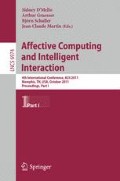Abstract
In this paper, we present the detailed phonetic annotation of the publicly available AVLaughterCycle database, which can readily be used for automatic laughter processing (analysis, classification, browsing, synthesis, etc.). The phonetic annotation is used here to analyze the database, as a first step. Unsurprisingly, we find that h-like phones and central vowels are the most frequent sounds in laughter. However, laughs can contain many other sounds. In particular, nareal fricatives (voiceless friction in the nostrils) are frequent both in inhalation and exhalation phases. We show that the airflow direction (inhaling or exhaling) changes significantly the duration of laughter sounds. Individual differences in the choice of phones and their duration are also examined. The paper is concluded with some perspectives the annotated database opens.
Access this chapter
Tax calculation will be finalised at checkout
Purchases are for personal use only
Preview
Unable to display preview. Download preview PDF.
References
Bachorowski, J.A., Smoski, M.J., Owren, M.J.: The acoustic features of human laughter. Journal of the Acoustical Society of America 110, 1581–1597 (2007)
Bennett, M.P., Lengacher, C.: Humour and laughter may influence health. III. Laughter and Health Outcomes. Evidence-based Complementary and Alternative Medicine 5(1), 37–40 (2008)
Boersma, P., Weenink, D.: Praat: doing phonetics by computer (version 5.2.11) (computer program), www.praat.org (retrieved on January 20, 2011)
Carletta, J.: Unleashing the killer corpus: experiences in creating the multi-everything AMI Meeting Corpus. Language Resources and Evaluation Journal 41(2), 181–190 (2007)
Chafe, W.: The Importance of not being earnest. In: The Feeling Behind Laughter and Humor., paperback 2009 edn. Consciousness & Emotion Book Series, vol. 3. John Benjamins Publishing Company, Amsterdam (2007)
Cox, T.: Laughter’s secrets: faking it – the results. New Scientist (July 27, 2010), http://www.newscientist.com/article/dn19227-laughters-secrets-faking-it--the-results.html
Esling, J.H.: States of the larynx in laughter. In: Proc. of the Interdisciplinary Workshop on the Phonetics of Laughter, Saarbrücken, Germany, pp. 15–20 (2007)
Hunt, A., Black, A.: Unit selection in a concatenative speech synthesis system using a large speech database. In: ICASSP, pp. 373–376. IEEE, Los Alamitos (1996)
Janin, A., Baron, D., Edwards, J., Ellis, D., Gelbart, D., Morgan, N., Peskin, B., Pfau, T., Shriberg, E., Stolcke, A., et al.: The ICSI meeting corpus. In: Proc. of ICASSP 2003, vol. 1, p. I–364. IEEE, Hong-Kong (2003)
Kennedy, L., Ellis, D.: Laughter detection in meetings. In: NIST ICASSP 2004 Meeting Recognition Workshop, Montreal, pp. 118–121 (2004)
Knox, M.T., Morgan, N., Mirghafori, N.: Getting the last laugh: automatic laughter segmentation in meetings. In: INTERSPEECH 2008, Brisbane, Australia (2008)
Ladefoged, P.: A course in phonetics, http://hctv.humnet.ucla.edu/departments/linguistics/VowelsandConsonants/course/chapter1/chapter1.html (consulted on January 20, 2011)
Lasarcyk, E., Trouvain, J.: Imitating conversational laughter with an articulatory speech synthesis. In: Proc. of the Interdisciplinary Workshop on the Phonetics of Laughter, Saarbrücken, Germany, pp. 43–48 (2007)
Mahony, D.L.: Is laughter the best medicine or any medicine at all? Eye on Psi. Chi. 4(3), 18–21 (2000)
Petridis, S., Pantic, M.: Is this joke really funny? Judging the mirth by audiovisual laughter analysis. In: Proc. of ICME 2009, New York, USA, pp. 1444–1447 (2009)
Pompino-Marschall, B., Kowal, S., O’Connell, D.C.: Some phonetic notes on emotion: laughter, interjections and weeping. In: Proc. of the Interdisciplinary Workshop on the Phonetics of Laughter, Saarbrücken, Germany, pp. 41–42 (2007)
Ruch, W., Ekman, P.: The expressive pattern of laughter. In: Kaszniak, A. (ed.) Emotion, Qualia and Consciousness. World Scientific Publishers, Tokyo (2001)
Sundaram, S., Narayanan, S.: Automatic acoustic synthesis of human-like laughter. Journal of the Acoustical Society of America 121(1), 527–535 (2007)
Szameitat, D.P., Alter, K., Szameitat, A.J., Wildgruber, D., Sterr, A., Darwin, C.J.: Acoustic profiles of distinct emotional expressions in laughter. The Journal of the Acoustical Society of America 126(1), 354–366 (2009)
Tokuda, K., Zen, H., Black, A.: An HMM-based speech synthesis system applied to english. In: 2002 IEEE TTS Workshop, Santa Monica, California (2002)
Trouvain, J.: Segmenting phonetic units in laughter. In: Proc. of the 15th International Congress of Phonetic Sciences, Barcelona, Spain, pp. 2793–2796 (2003)
Truong, K.P., van Leeuwen, D.A.: Evaluating automatic laughter segmentation in meetings using acoustic and acoustic-phonetic features. In: Proc. of the Interdisciplinary Workshop on the Phonetics of Laughter. Saarbrücken, Germany (2007)
Urbain, J., Bevacqua, E., Dutoit, T., Moinet, A., Niewiadomski, R., Pelachaud, C., Picart, B., Tilmanne, J., Wagner, J.: The AVLaughterCycle database. In: Proc. of LREC 2010, Valletta, Malta (2010)
Urbain, J., Niewiadomski, R., Bevacqua, E., Dutoit, T., Moinet, A., Pelachaud, C., Picart, B., Tilmanne, J., Wagner, J.: AVLaughterCycle: Enabling a virtual agent to join in laughing with a conversational partner using a similarity-driven audiovisual laughter animation. JMUI 4(1), 47–58 (2010), special Issue: eNTERFACE 2009
Author information
Authors and Affiliations
Editor information
Editors and Affiliations
Rights and permissions
Copyright information
© 2011 Springer-Verlag Berlin Heidelberg
About this paper
Cite this paper
Urbain, J., Dutoit, T. (2011). A Phonetic Analysis of Natural Laughter, for Use in Automatic Laughter Processing Systems. In: D’Mello, S., Graesser, A., Schuller, B., Martin, JC. (eds) Affective Computing and Intelligent Interaction. ACII 2011. Lecture Notes in Computer Science, vol 6974. Springer, Berlin, Heidelberg. https://doi.org/10.1007/978-3-642-24600-5_43
Download citation
DOI: https://doi.org/10.1007/978-3-642-24600-5_43
Publisher Name: Springer, Berlin, Heidelberg
Print ISBN: 978-3-642-24599-2
Online ISBN: 978-3-642-24600-5
eBook Packages: Computer ScienceComputer Science (R0)

